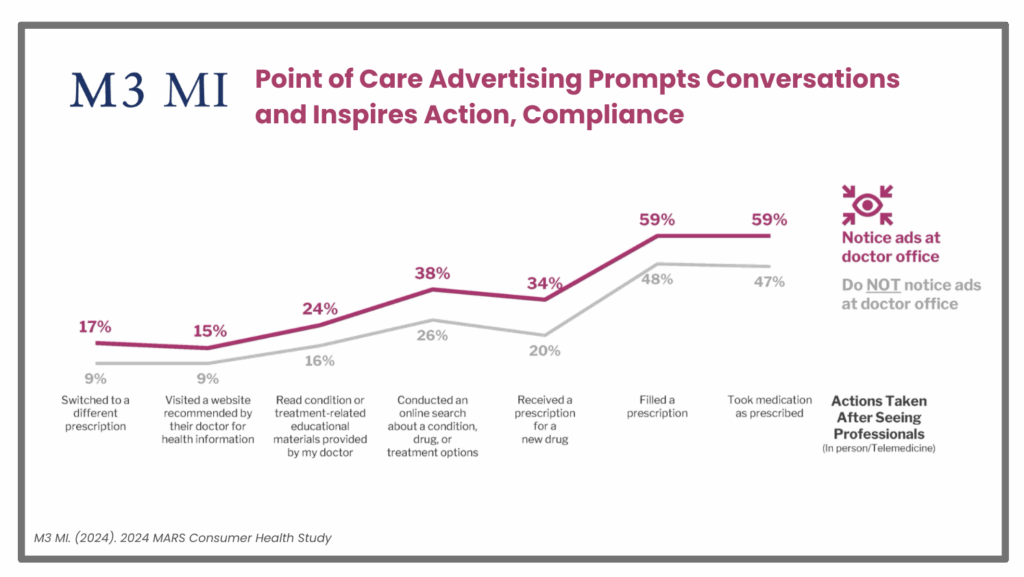
In today’s complex healthcare landscape, reaching patients and providers with the right message at the right time is more critical—and more challenging—than ever. We believe that one of the most powerful touchpoints in that journey is the Point of Care (POC).
The Point of Care Marketing Association is the leading organization for the POC channel. So, naturally, we know a thing or two about POC. And we feel it’s our job to educate you on what POC is by starting with the basics – what POC is, why it matters and how you can engage with this powerful channel.
Whether you’re a marketing strategist at a pharmaceutical brand, an agency partner or a policymaker exploring how access to information shapes healthcare decisions, understanding the full scope of Point of Care and POC media is essential to staying informed.
This post breaks down the key definitions and concepts about POC that you need to know—starting with the foundation of what point of care is, and key insights on the value and impact of reaching patients and healthcare providers at the point of care.
The Basics: Understanding the Point of Care
What is Point of Care?
Point of Care is defined as the moment a patient receives care via an interaction with a healthcare professional in a healthcare setting. This includes in doctor offices, pharmacies, hospitals, other healthcare facilities and even on virtual care platforms.
These settings provide high-impact moments in the care journey when patients are receptive, providers are influential and healthcare decisions are being made.
Why is Point of Care Important?
Education at the point of care helps patients, caregivers and providers engage in more meaningful conversations—building shared awareness of conditions, treatment options, care experiences and decisions that shape outcomes. Education at the point of care also supports both sides of the care conversation with timely, relevant information that deepens understanding, strengthens trust and empowers collaboration throughout the care journey.
This education can come in the form of guidance from healthcare professionals (HCPs), but it can also come in the form of messaging from pharmaceutical brands who are seeking to raise awareness about treatment options that can improve patient outcomes.
For example, a Psoriasis medication brand might offer educational information in a doctor’s exam room. This becomes a pivotal moment for a patient suffering from Plaque Psoriasis who may start a conversation with their doctor after seeing the message.
Key Terms to Know:
- POC Setting: Any healthcare environment where clinical decisions happen, including primary care clinics, retail pharmacies, hospitals, urgent care centers, specialty practices and virtual care platforms.
- HCP (Healthcare Professional): Physicians, nurse practitioners, physician assistants, pharmacists and other clinicians directly involved in delivering care.
- Patient Education: The process of informing patients about their conditions and treatment options, often supported by handouts, digital tools or conversations during visits.
- Care Journey: The path a patient takes from symptom onset through diagnosis, treatment, and ongoing management—often requiring multiple touchpoints across different POC settings.
POC as a Channel: What is Point of Care Media?
Point of Care Media refers to targeted communications designed to reach patients, caregivers and/or providers before, during, and/or after a clinical interaction—at or near the point of care. The goal of these communications is to facilitate informed discussions between healthcare professionals and patients and, ultimately, improve patient outcomes.
Where Is POC Media Delivered?
POC media can be integrated into every step of the patient journey:
- Before the visit: Through mobile targeting and pre-appointment education.
- During check-in: Via tablets, digital signage or mobile campaigns.
- In waiting rooms: Through digital screens, cover wraps, posters and magazines.
- In exam rooms and hospitals: With digital wallboards, anatomical screens, interactive print and digital stethoscope displays.
- In back offices and nurse stations: Reaching HCPs with medical updates, product news and clinical support via their Electronic Health Record (EHR).
- After the visit: Through take-home materials, patient kits, pharmacy messaging and mobile follow-ups.
What Forms Does POC Media Take?
Messaging at the Point of Care can be delivered across a variety of different media formats:
- Digital: Screens, tablets, mobile, and electronic health record (EHR) – integrated platforms offer flexible, targeted messaging and real-time reporting.
- Print: Posters, brochures, wallboards, magazines, and table tents ensure consistent, visual presence across settings.
- Medical Essentials: Branded table paper, bandages, samples, and discharge kits provide subtle but effective messaging.
The Audience: Who is Engaged at the Point of Care? Who Gets Exposed to POC Media?
Patients, their caregivers and the HCPs that serve them are the main audiences reached at the Point of Care.
Patients at the POC are prepared, eager for answers and open to suggestions from their HCPs – someone they consider a partner in their journey to well-being.
Patients and Caregivers
Today’s patients are more empowered and informed than ever before. Nearly 60% of consumers actively use online resources to research symptoms, treatments, and healthcare providers before consulting a physician4. And 54% of patients research treatment options on their own and then ask their doctor about them, up 10% since 20225. This means that many patients arrive at appointments prepared, curious, and often already having researched their condition.
POC media helps patients:
- Start difficult conversations
- Overcome hesitations due to low health literacy or fear of judgment
- Feel confident and supported in advocating for their own care
Patients value POC more than ever, and healthcare advertising at the doctor’s office prompts them to act. According to M3 MI’s 2024 MARS Consumer Health Study and 2024 Physician Digital Insights Study:
- Health information at POC is ranked #4 for top patient health sources
- Among patients and caregivers who saw/heard a healthcare ad in a doctor’s office, 58% are willing to ask their doctor for a prescription
- 89% of patients value pharmacists
- Nearly 2 in 3 value printed brochures or other take home materials from a pharmacy
Healthcare Professionals (HCPs)
POC media also supports HCPs with tools they use throughout their workday:
- 51% physicians are more receptive to targeted content/ads on professional sites
- 70% of physicians would provide more support materials and tools if they were more customized to their patients
- 55% of physicians use EMR/EHR or Telemedicine Platforms to forward pertinent education materials to the patient.
Messaging seeking to reach HCPs may include EHR messaging, custom magazines, clinical support kits, sample programs, or in-office signage—all designed to reinforce care plans and treatment discussions.
The Next Step: What Patients Do Following Interactions at the Point of Care
So what happens once patients finish a POC interaction. Point of care experiences educate and empower patients to have a more informed conversation with their HCP.
After engaging with messaging at the point of care, patients often take concrete steps that can significantly improve outcomes. They may:
- Ask about new treatment options: Education at the POC prompts patients to initiate conversations about medications or therapies they may not have otherwise considered.
- Request prescriptions or referrals: Patients may ask their provider to prescribe a featured medication or refer them to a specialist or service.
- Change or start a treatment plan: Seeing messaging aligned with their symptoms or goals may inspire patients to commit to care plans or initiate lifestyle changes.
- Share information with caregivers: Materials from the POC can serve as conversation starters at home or with loved ones.
- Become more adherent: Reinforcement at the point of care can help improve medication adherence and appointment follow-through.
These behaviors demonstrate the real-world impact of engaging patients at critical moments—when they are open, attentive, and empowered to make decisions.

This is why we believe that POC should be a cornerstone of all healthcare marketing strategies in 2026.
Learn More about POC with the Point of Care Academy
If you’re ready to go deeper and learn more about POC, the Point of Care Academy offers a growing library of self-paced courses designed to educate healthcare marketers, agencies and industry stakeholders on the full scope of point of care media.
Explore courses on:
- The fundamentals of POC marketing
- Audience targeting and patient engagement
- Creative strategy and media formats
- Measurement, ROI, and regulatory alignment
Start learning today and become a more informed partner in driving health outcomes at the moment they matter most.
Meaningful Interactions Take Place at the Point of Care
Point of Care isn’t just a place—it’s a moment. And for patients navigating complex health decisions, that moment can be everything.
By understanding the settings, tactics and the strategies shaping point of care today, brands can play a role in advancing more informed, more connected and more patient-centered healthcare.
Sources:
- www.cdc.gov/nchs/data/ahcd/namcs_summary/2018-namcs-web-tables-508.pdf
- Clarivate study, Taking the Pulse US 2021
- www.fiercehealthcare.com/practices/primary-care-doctors-spend-more-than-50-workday-ehr-tasks
- Deloitte. (n.d.). The future of health: A focus on the consumer. Deloitte. Retrieved January 27, 2025
- M3 MI. (2024). 2024 MARS Consumer Health Study
